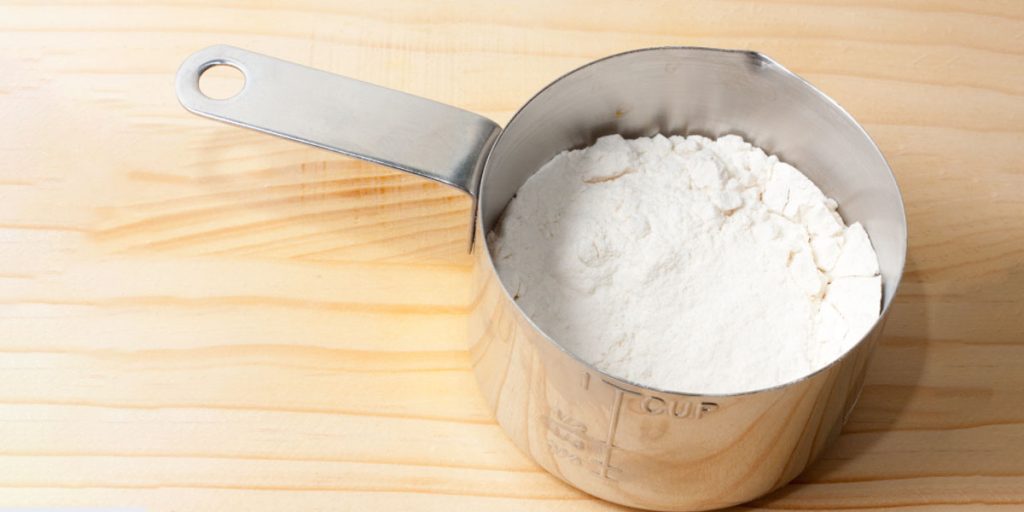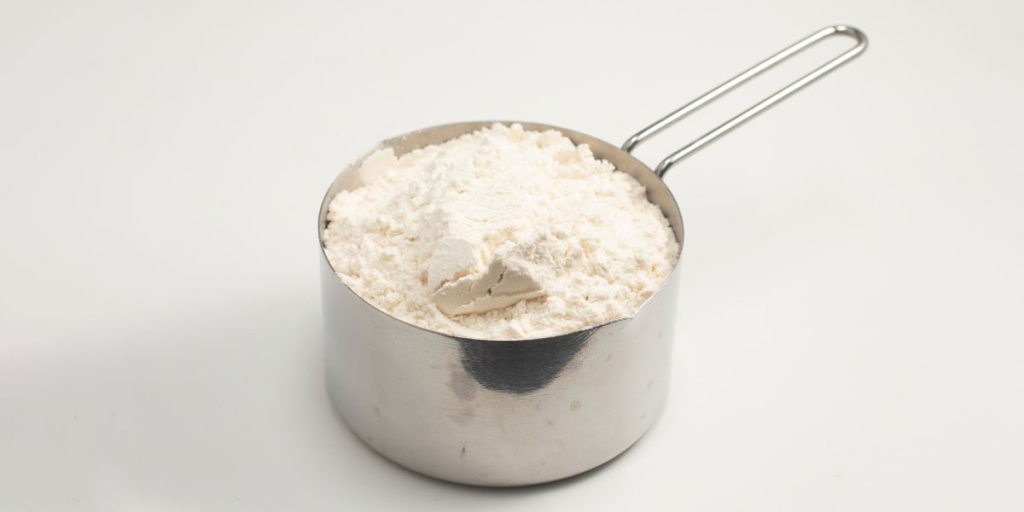Five cups of flour approximately weigh 600 grams or 1.32 pounds. The exact weight can vary slightly based on the type of flour and how it is measured.
Baking precision often calls for exact measurements, and when it comes to flour, weight is considered more accurate than volume.
This is particularly important for bakers and chefs who strive for consistency and perfection in their recipes.
Understanding the weight of flour can significantly affect the texture and structure of baked goods.
Precise measurements ensure recipes are repeatable and yield the desired results, whether you’re a professional pastry chef or a home baker experimenting with new recipes.
As various recipes call for cups or grams, it’s handy to know the weight equivalent for conversion.
The Basics Of Measuring Flour
Understanding how to measure flour correctly is crucial for perfect baking. The weight of flour can vary based on the method used to measure it.
Let’s explore the methods and tools for getting flour measurements just right.
Scoop-and-sweep Method Versus Spoon-and-level
Two common techniques are used when measuring flour: the scoop-and-sweep method and the spoon-and-level method.
- Scoop-and-Sweep involves scooping flour with a measuring cup and sweeping off the excess with a knife.
- The Spoon-and-Level technique means spooning flour into a measuring cup and leveling off the top.
Which method is better? The Spoon-and-Level method often provides a more accurate measure for consistent baking results.
Weight Versus Volume: Precision In Baking
In baking, precision is key. Ingredients like flour can be measured by weight or volume. But which one is best?
| Method | Precision | Why Use It? |
|---|---|---|
| Weight (grams, ounces) | High | Offers consistency in recipes, reducing error. |
| Volume (cups, tablespoons) | Lower | Convenient and quick for non-precision baking. |
Weighing flour using a kitchen scale ensures precision. Five cups of flour typically weigh around 600-625 grams.
However, this can vary with the measuring approach. To ensure the best outcomes, weighing ingredients is recommended.
Types Of Flour And Their Weights

Bakers know that the type of flour used in recipes is crucial. Different flours have unique weights.
This affects measurements and the outcome of your baked goods. Let’s explore the weights of various flours.
Weight Differences Between All-purpose, Bread, And Cake Flours
Not all flours weigh the same. This is because of how they are milled. Each flour has the density that changes its weight.
| Flour Type | Weight for 1 Cup (in grams) | Weight for 5 Cups (in grams) |
|---|---|---|
| All-Purpose Flour | 125g | 625g |
| Bread Flour | 130g | 650g |
| Cake Flour | 120g | 600g |
Remember, to use the spoon and level method for the most accurate measurements. It gives better results.
Impact Of Flour Type On Baking Results
The type of flour also changes how your baked goods turn out. Flour type affects texture and structure.
- All-Purpose Flour: Versatile, used in most recipes.
- Bread Flour: More gluten, creates chewy loaves.
- Cake Flour: Less protein, results in a tender crumb.
Choosing the right flour ensures your baking success. Every type serves a specific purpose in baking.
What Weighs More: A Guide To Measuring
Measuring ingredients can be tricky. It’s all about precision. For success in the kitchen, it’s vital to understand weights. But not all flours weigh the same.
A cup of one may be heavier than another. Let’s dive into the world of flours and their different weights.
Density And Weight Considerations
Flour types are many. Each kind has a unique density. This means weight varies. Think about all-purpose versus whole wheat.
They don’t weigh the same per cup. Even the way you fill a cup affects weight. Fluffing, spooning, and leveling matter.
Compacted flour weighs more. For accurate results, know your flour’s density.
Here’s a look at common flour types and their approximate weights per cup:
- All-purpose flour: 4.25 oz or 120 grams
- Whole wheat flour: 4.5 oz or 128 grams
- Bread flour: 4.8 oz or 136 grams
- Cake flour: 4 oz or 113 grams
Different flours weigh differently due to their density. Understanding this helps in cooking and baking.
5 Cups Flour In Ounces And Grams
Let’s convert weight for 5 cups:
| Type of Flour | Weight Per Cup (ounces) | Weight for 5 Cups (ounces) | Weight Per Cup (grams) | Weight for 5 Cups (grams) |
|---|---|---|---|---|
| All-purpose flour | 4.25 | 21.25 | 120 | 600 |
| Whole wheat flour | 4.5 | 22.5 | 128 | 640 |
| Bread flour | 4.8 | 24 | 136 | 680 |
| Cake flour | 4 | 20 | 113 | 565 |
Multiply the weight per cup by five. This gives the weight for five cups. Note that packing methods impact results. Use weight for best accuracy in recipes.
Common Pitfalls In Flour Measurement

Measuring flour seems simple yet tricky. The weight of 5 cups can vary greatly. Baking requires precision. Without it, recipes can fail. Here are some common mistakes and how to avoid them.
Avoiding The Pack-down Problem
Measuring flour without packing it down is crucial. Flour settles naturally. Pressing it into a cup adds excess.
This makes the flour denser and your measurement heavier than needed. To avoid this:
- Fluff the flour first. Use a spoon to aerate it in the container.
- Spoon it into the cup. Gently fill without shaking or tapping.
- Level it off. Use a straight edge to remove excess.
Humidity And Its Effect On Flour Measurement
Humidity adds weight to flour. It absorbs moisture from the air. This changes the weight. It can ruin recipes. To measure flour accurately, regardless of humidity:
- Store flour properly. An airtight container is best. It keeps moisture out.
- Adjust the recipe if needed. A kitchen scale is your friend. It measures the exact weight.
- Keep an eye on the weather. On humid days, flour weighs more. Compensating for this can save a recipe.
Expert Tips For Perfect Flour Measurement
Accurate measurement is key to successful baking. Precise amounts ensure perfect results every time. Flour poses a unique challenge.
Its weight can change based on conditions like humidity and how settled it is. For reliable outcomes, consider these expert tips.
The Role Of Kitchen Scales In Baking
Kitchen scales bring precision to the baking process. Bakers value consistency. A cup of flour scooped from the bag may not weigh the same each time. Conditions vary.
Flour settles differently. A scale measures exactly, removing guesswork.
For 5 cups, weights differ: a cup of all-purpose flour typically weighs 120 to 125 grams. Five cups might weigh between 600 to 625 grams.
Use a kitchen scale. It’s the baker’s secret for accuracy.
- Zero the scale with an empty bowl on top.
- Pour flour until you reach the desired weight.
- Avoid packing the flour; let it settle naturally.
Converting Flour Measurements For International Recipes
International recipes challenge bakers with different measurement standards. Grams, ounces, and cups may differ. Understanding conversions ensures successful baking across borders.
| Measurement | Weight in Grams |
|---|---|
| 1 cup (US) | 120-125g |
| 1 cup (UK) | 150g |
| 1 cup (AU) | 125g |
Conversion tools are vital. Find reliable sources online or use kitchen tools with multiple measurements.
Be mindful of ingredient types too; each has a unique weight. All-purpose flour differs from bread flour or cake flour.
- Check the recipe’s origin.
- Use conversion tools to adjust.
- Double-check with multiple sources for accuracy.
Recipe Adjustments When Measuring Goes Wrong
When baking, precision is key. You might find yourself squinting at your measuring cup, second-guessing if you’ve measured correctly.
Too much or too little flour can change the texture of your baked goods. Seeing that 5 cups of flour typically weigh around 600g to 625g (120g-125g per cup if using the dip and sweep method), it’s easy for measurements to go wrong.
What happens if they do? Don’t despair; it’s possible to save your recipe with a few adjustments.
Correcting Over-measured Flour
If you’ve added too much flour, it might make your dough or batter dry. To correct this, follow these steps:
- Add liquid — for every extra 1/4 cup of flour, add 1-2 tablespoons of the recipe’s main liquid.
- Extra mixing time — work in the additional liquid slowly to avoid overmixing.
- Test consistently — after each addition, check the consistency before adding more.
How To Compensate For Under-measurement?
Finding your mixture too wet or runny signals under-measuring flour. To fix the issue, take the following steps:
- Spoon in extra flour — incorporate more flour, one tablespoon at a time.
- Gentle folding — use a spatula to fold in the flour gently.
- Rest the dough — if possible, let the dough rest for a few minutes to absorb the new flour.
Understanding flour weights and measurements can save your recipe from disaster. With these tips, turning a potential baking fail into a success is within reach.
Measure carefully and adjust as needed to ensure delicious results every time.
FAQs About the Weight of 5 Cups of Flour
What Is The Weight Of 5 Cups Of Flour?
The weight of 5 cups of flour typically ranges from 600g to 625g. This can vary slightly based on the flour type and how densely it’s packed.
How Many Grams Per Cup Of Flour?
One cup of all-purpose flour weighs approximately 120g to 125g. Measurements can vary with different flour types and settling.
Can Flour Weights Vary By Type?
Yes, flour weights can vary by type. For example, whole wheat flour is heavier than white flour, affecting the total weight of 5 cups.
Why Measure Flour By Weight, Not Volume?
Measuring flour by weight is more accurate than volume, helping ensure consistent results in baking, as flour can settle or become aerated in the cup.
Conclusion
Understanding the weight of 5 cups of flour is essential for any baking enthusiast. Precise measurements lead to better baking results.
Remember, different flours have different densities. Generally, 5 cups weigh approximately 600-625 grams. For perfect recipes, consider a kitchen scale.
Happy baking and may your measurements always be spot-on!
Resources:
https://www.fda.gov/food/buy-store-serve-safe-food/handling-flour-safely-what-you-need-know
https://www.ncbi.nlm.nih.gov/pmc/articles/PMC7400821/
